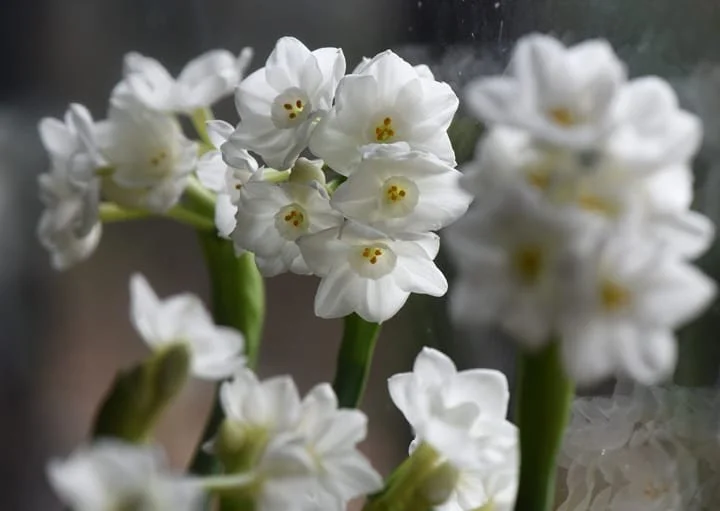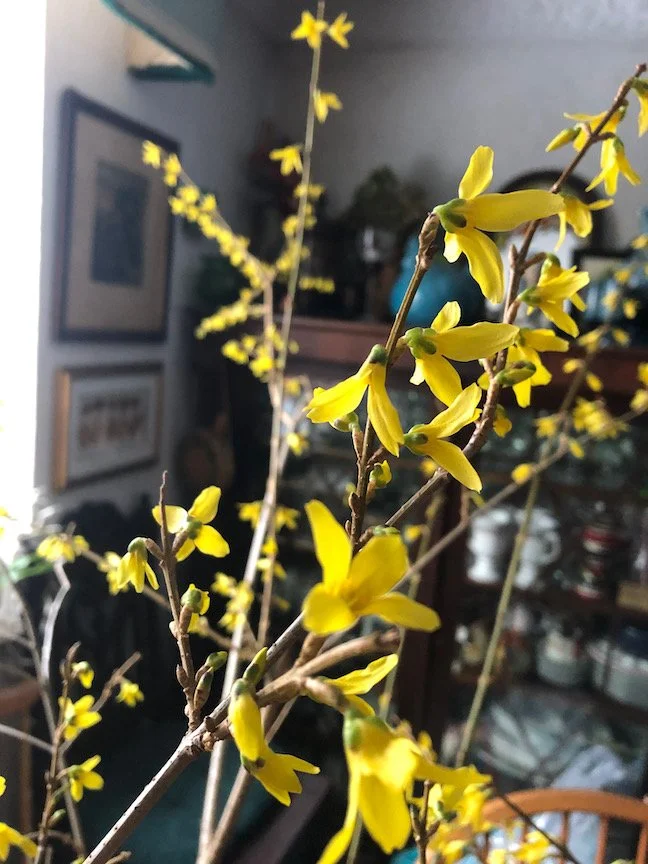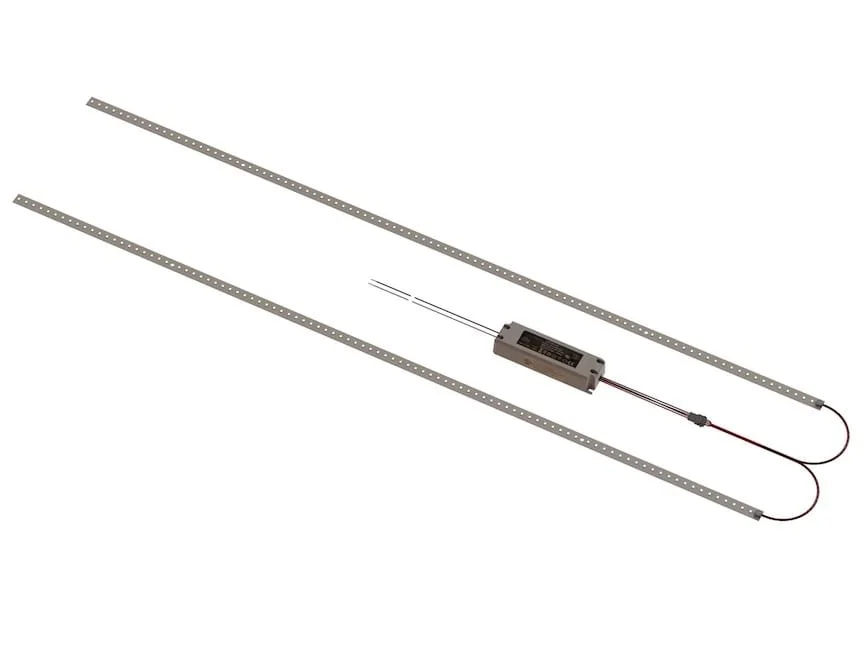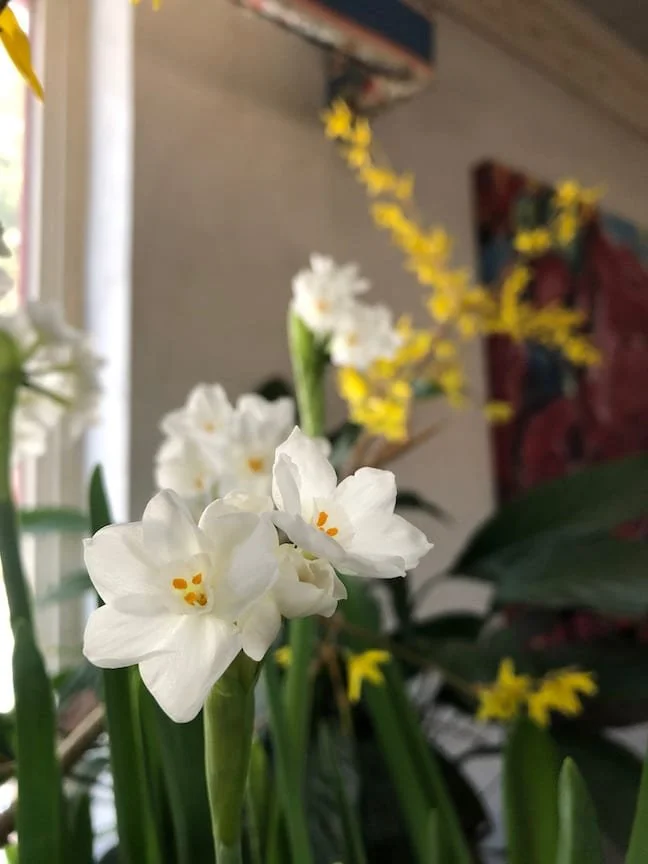Winter Adventures in Indoor Gardening: Happy Accidents, Houseplant Tips, and More
The heavy aroma of paperwhites fills the living room, much to my wife’s chagrin.
She reluctantly agrees to let me start a few at a time once a week or so, knowing the flowers keep me sane as winter drags on.
They are an indoor, white blooming daffodil with a fragrance you either love or hate. It’s wonderful to have something flowering until we can get back outside.
For years I repeated what I was taught about growing paperwhites, that after the plants had finished blooming, they should be sent to the compost pile. By chance, I found out they can be made to rebloom.
One of the things I love about gardening is the happy accidents.
So last year I put the pots of spent paperwhites in my ancient, unheated greenhouse. At first, I figured they would not survive, assuming they were tender. The pots were stuck up on a corner of a shelf and forgotten.
After a hot dry summer where temperatures under glass were often 100 degrees, a fall rain dripped through the leaky old windows awakening some of the bulbs. While sowing some seeds for winter greens, I noticed the foliage sprouting, watered the other pots, and in a few weeks, the flowers put on their show. I can’t wait to duplicate the conditions this season for more blooms.
Paperwhites are beautiful bulbs for indoor flowers that have an intense fragrance. Photos by Doug Oster.
When amaryllis bulbs are treated the same way, they will also rebloom annually. The key is that dry dormant period, in this case about six to eight weeks to make them flower again next year.
Both are often grown as holiday plants, but they provide a much-needed taste of gardening while snow still covers the ground. This video explains how to grow and winter over the plants in more detail. The nice thing about growing them all the way through winter instead of just starting them in November or December is that blooms will arrive at different times of the year.
Blooming right now, in consort with the paperwhites, are luminescent, yellow forsythia flowers that have been forced to flower indoors early.
There is nothing easier than forcing the branches of forsythia, pussy willow, peach, cherry, magnolia, and other plants that put their buds on the year before in anticipation of spring.
Cut the branches as long as you want, be aware of how much height you have inside to display them, and then put them in a vase filled with water. Sometimes I will slit the bottom of the branches vertically using pruners to allow more water to be drawn up. Be sure to keep the vase full, as the plants will uptake a lot of water. In a week or so, the branches will start to bloom as a prelude to spring.
Forsythia branches cut and brought inside for winter gardening - photo by Doug Oster
One of the easiest winter gardening jobs is cutting forsythia branches and forcing them to bloom indoors.
There are later blooming plants that can be made to flower the same way, like dogwoods and azaleas. With any force, it seems the closer to the “normal” bloom time, the more success is had in flowering. When the buds begin to swell on their own, it’s easier to coax them to flower. Forsythia is such a good choice now because it’s happy to bloom early, and we need it more than ever. By the time some later bloomers are ready, most of us have moved on to outdoor gardening in full force.
Doug’s Free Seed Shacks
I’m excited to partner with Farm to Table of Western Pennsylvania for my latest new project. I’ve converted six old newspaper sales boxes into free seed libraries. They are the kind you would feed quarters to, open the front and pull out a paper.
Five of them are placed around the area and one is moved every so often around Western Pennsylvania to hopefully, give everyone has a chance to get some interesting seeds to try. Some boxes are located in the city and others in the suburbs and beyond.
Here's where you can find themif you're looking for seeds.
LED Lighting for Indoor Garden
One thing about being old (and wise?), is that oftentimes technology moves too quickly to keep up with. On a recent visit to see my friend “Handy” Andy Amrhein, owner of Evey True Value Hardware in Bethel Park, he showed me a new type of lighting fixture which could be used for indoor growing.
The Optilumen light package includes something called an LED driver which powers two 45-inch-long LED lights. Each has the brightness of two fluorescent bulbs and uses much less energy. The amazing thing is that they are magnetized and could actually be put on an old shop light or anything metal. There are also holes so they could be attached to some support with screws too.
The lighting package was $50, I bought an old metal cabinet for $40 from Construction Junction, some reflective tape, and a timer from Hastings Hardware (my local hardware store) and now I’ve got everything I need to set up an indoor system for about $100. One word of props for both of these hardware stores, they aim to please and are a wealth of knowledge. At Hastings, they actually opened the packaging on the timer and set it for me as they know I don’t know which side of a hammer to use.
I’ll be making a video soon, showing how the whole thing goes together. A good light source is important for indoor seed starting, this story has some good information about sowing seeds indoors.
LED Lights from Opitumer
These LED lights from Optilumen were found locally at Evey True Value Hardware in Bethel Park.
Houseplant Tip
This is a great time to gather up houseplants and throw them in the shower. The leaves should be cleaned so the plant can perform its best. It’s also good to flush out the soil once a year. It’s best to do this flushing right before the plants need to be watered as houseplants like it dry.
I wrote about some new, cool plants for the windowsill here and how to make more of them by taking cuttings here.
Longer days also mean it’s time to fertilize houseplants beginning in February. A good liquid, an organic fertilizer will make them thrive. I’ve fallen in love with Drammatic from the Dramm company. For the past two seasons, I’ve used it exclusively inside and out. This fish-based fertilizer is bought as a concentrate and then mixed with water. It smells like low tide for a day or two and then the “fragrance” is gone. One 32-ounce container might last you all season. It’s available locally at Chapon’s Greenhouse and Hahn Nursery. It also can be purchased online.
Looking for one more fun winter gardening project? How about planting and eating some microgreens? Here’s how it’s done, from a previous Green Voice column.
As the days get longer and until they get warmer, there’s still lots to do inside to keep the gardening flame burning.
Having blooms indoors is one of the things that keeps gardeners sane. These paperwhites are fragrant and are set off by forced forsythia branches for a little taste of spring.





